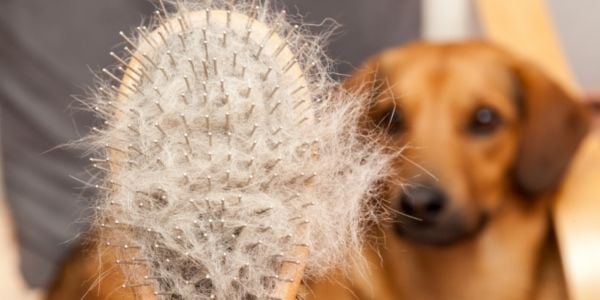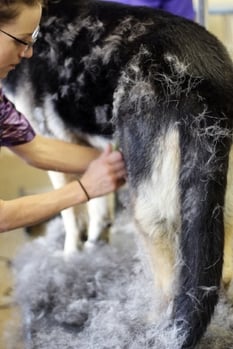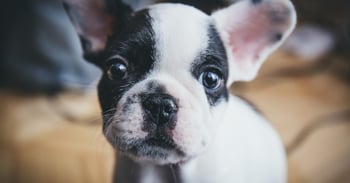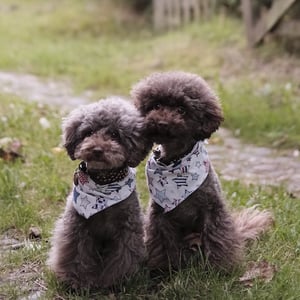
Dog fur always seems to get everywhere — on your clothes, on the furniture, in your coffee, even little fur tumbleweeds that float across the floor.
Keeping your dog brushed will help you minimize the layer of fur over everything and promote healthy skin and a shiny coat.
But what kind of dog brush should you keep handy? This all depends on your dog's coat type. Read on for tips on how to pick the most effective brush for your dog.
Skip to Section:
Brushing Benefits
How Often You Should Brush Your Dog's Coat
The Best Dog Grooming Tools and Techniques for:
Smooth-Coated Breeds
Single-Layer, Minimally Shedding Breeds
Double-Coated Breeds
Benefits of Brushing Your Dog's Coat
- Regular brushing prevents matting. Mats can cause serious skin issues, painfully pull and pinch at your dog’s skin, and can hide some nasty critters such as fleas or maggots ... gross! Once mats have formed in your dog’s coat, it can be painful for your dog and difficult to remove them yourself — and it’s best done by a professional groomer.
- Regular brushing keeps your dog cooler. Dogs with undercoats need to avoid any fur impacted against the skin to allow airflow and stay cool.
- Regular brushing builds the bond between you and your dog.
- Regular brushing helps you spot anything unusual, such as parasites, lumps, or sores.
- Regular brushing keeps your dog’s skin and coat healthy. Brushing helps to distribute your dog’s natural oils throughout their coat, keeping their fur nice and shiny.
- Brushing helps cut down on your dog’s shedding. Better the fur on the brush than on your micro suede couch!

How Often Should You Brush Your Dog’s Coat?

Maintenance Brushing
While maintaining your dog’s coat health can seem daunting, it’s important that you make sure you’re brushing it correctly based on your dog’s fur type, and that you’re brushing it regularly. I recommend brushing your dog’s coat at least every couple of days, even for short-coated dogs.
If you have a dog with a higher maintenance coat, such as a poodle, poodle mix (these coats can be especially prone to matting), or a double-coated dog (e.g., Akita, Husky, Sheltie, Great Pyrenees), brushing daily is best. If you keep up on brushing, you’ll only need to do it for a few minutes each day to keep their coat in tip-top shape.
If you have a breed that requires regular clipping and you’d like to keep their coat length long, you will need to stay on top of brushing. Otherwise, they will have matting when they go in for their grooming appointment and most likely will need to be clipped to the length of the coat left under the mat (which is most often pretty short and close to the skin).
If maintaining a regular brushing schedule at home is too difficult, you can schedule simple brush out appointments with many groomers, or just a bath, blow-dry, and brush out service in between full grooming appointments.
After Swimming or Getting Wet
It’s a good idea to brush and thoroughly dry your dog's coat after any swimming to prevent mats (and painful "Hot Spots"). A super absorbent dog shammy towel is great to keep on hand if you don't plan on blowing them dry after a swim. Take a minute or two to brush out leg and foot fur if they get wet running around the yard or after a walk in the rain — this will help prevent painful matting on their legs and feet.
Before and After a Bath
Brushing out your dog's coat before bath makes your job easier. Removing any loose fur with a brush first means you'll have less of it in your tub drain. It also means that your shampoo and conditioner will be able to penetrate your dog's coat more easily, resulting in a cleaner dog and healthier skin! (See the Pro Tip below about another pre-bath Blow Out technique.)
Take the time to blow dry, and brush out your dog after a bath as well, to remove any fur that was loosened during the bath and prevent matting from forming as their coat dries.
During Shedding Season
If you have a dog with an undercoat (e.g., Labrador Retriever, Corgi, Husky), you’ll notice that there are certain times of the year when they blow their coat. This is when their fur is changing between winter and summer coats. Full-on molting time! Brushing them every day for at least 15 minutes during their coat blow will help speed up the process, keep them comfortable, and stop the furballs from falling out all around your home.
Best Dog Grooming Tools and Techniques for Your Dog’s Coat Type
So now that you’re starting on a regular brushing regimen, it’s time to stock up on tools that will make it easier. The types of brushes you’ll need depend on your dog’s coat type and whether you’re “brushing for business” or “brushing for pleasure.”
Smooth-Coated Breeds
Boxers, Boston Terriers, French Bulldogs, Pugs, Vizslas, Dobermans, Great Danes, Greyhounds, etc.
 Dogs with short and smooth coats are easy to keep clean, but you'll notice that they shed just as much as other longer-coated breeds. The best brushes for these dogs are the rubber curry-style brush, a grooming mitt, and a bristle brush.
Dogs with short and smooth coats are easy to keep clean, but you'll notice that they shed just as much as other longer-coated breeds. The best brushes for these dogs are the rubber curry-style brush, a grooming mitt, and a bristle brush.
The rubber brushes work wonders during a bath to create a nice, rich shampoo lather that penetrates the coat to your dog's skin. The soft rubber tips also stimulate your dog's skin as you massage.
After the bath, or between baths, the rubber brush does the best for de-shedding when your dog's coat is completely dry. Brush in a circular motion or in reverse over your dog's coat to loosen the fur. You can then wipe them down with a grooming mitt, going in the same direction as your dog's coat, or use a bristle brush to remove the loose fur and dirt.
My personal favorite is the Furbliss Brush, which doubles as a handy fur remover for furniture, clothing, or car interiors when using the back side. It's also easy to clean — just rinse with water, or toss in the dishwasher or washing machine. Another popular option is the Kong Zoom Groom, which has sturdy rubber knobs that are great for massage.
Pro Tip: You can use the Furbliss Brush to remove dog hair on furniture, area rugs, car seats, and more. In this video it's being used on the fleece underside of a Preventive Vet dog's rain jacket. Works like a charm!
Single-Layer, Minimally Shedding Breeds
Poodles, Bichon Frisés, Yorkshire Terriers, Malteses, Airedale Terriers, Shih Tzus, etc.
 Dogs in this category do not have the down-like undercoat layer of fur. You might have heard that dogs like Poodles have hair instead of fur — but technically hair and fur are the same thing! Both are made out of keratin.
Dogs in this category do not have the down-like undercoat layer of fur. You might have heard that dogs like Poodles have hair instead of fur — but technically hair and fur are the same thing! Both are made out of keratin.
However, some breeds do have a more fine texture of fur and a slower growth and shedding cycle. Due to the slow shedding rate, their fur grows much longer than double-coated breeds.
The fur that does shed usually gets tangled with the surrounding coat rather than falling off the dog — this is why matting happens in these dogs' coats at a much higher rate than other breeds. Which means it takes much more maintenance to keep their coat mat-free.
If you notice matting in your dog's coat that is tightly wound and close to the skin, it is best to see your local groomer to have them clip it out safely with grooming clippers.
Using scissors at home is dangerous as it's very easy to cut the skin underneath the mat. Read this article for tips and techniques on how to prevent mats and what to do when you see them in your dog's coat.
For routine brushing, start with a metal comb and gently comb through your dog's coat. If there are any spots where the comb can't easily go through the fur, use a slicker brush and use a line brushing technique to work through those areas.
To properly line brush, start at the lowest portion of the area you're brushing and lift a small portion of hair up. Brush the fur underneath the portion you're holding up, from the skin down. To see line brushing in action watch this great line brushing tutorial video:
Double-Coated Breeds
Short Double Coats (Labrador Retrievers, Corgis, Shiba Inus, etc.)
These coats can shed quite a lot, and regular brushing minimizes little fur balls around your home. A Furminator works quite well with these coats to pull out any loose undercoat fur. When furminating your dog's coat, make sure their coat is completely dry and don't brush too hard or for too long as it can irritate their skin and cause coat damage if overused.
The Furbliss, slicker brush or a grooming mitt also do well with these shorter double coats.
Medium to Long Double Coats (Siberian Huskies, Australian Shepherds, Bernese Mountain Dogs, Golden Retrievers, Alaskan Malamutes, etc.)
These thick-coated breeds benefit greatly from the line brushing technique described above, especially on their extra fluffy parts like their feathers and manes. Start with a comb to get an idea where they'll need deeper brushing with a slicker brush.
Some places to focus on with these thick coats include the back rump and thigh area (sometimes referred to as feathers, but I call this area "pantaloons"), around the neck, behind the ears, and armpits.
Pro Tip: One of the best kept grooming secrets for double-coated dogs is a Blow Out technique. Use a high-velocity grooming blow dryer, like this one from Shelandy to blow out the loose fur.
Regular blow dryers are not very effective as they don't have the air velocity needed, the directed airflow, and you don't want to blow dry with high heat. See a blow out in action in these videos:
You can blow out your dog's coat prior to giving them a bath to save you the time and energy of washing dead fur that ends up in the drain anyways, or use this technique in conjunction with regular brushing.
Amy Dallas, Professional Pet Stylist, contributed to the contents of this article.




